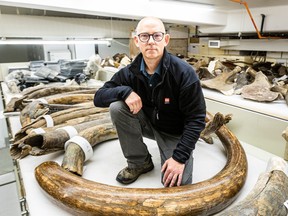There are a number of intriguing questions about Alaska mammoths, including whether their presence attracted humans to North America, Clément Bataille says.

Article content
The 1960s cartoon The Flintstones got a lot wrong when it came to prehistoric humans and their interactions with ancient animals. To start, humans did not coexist with dinosaurs, let alone ride them.
But humans did cross paths with woolly mammoths, and resourceful hunter-gatherers who had recently arrived in North America in the late Ice Age may have played a role in the mammoths’ extinction.
Advertisement 2
Article content
Article content
The exact nature of that relationship is being probed by an international team of researchers, including the University of Ottawa’s Clément Bataille.
Using high-resolution isotope profiling, Bataille and his colleagues analyzed a metre-long tusk belonging to a female mammoth named Élmayųujey’eh — known as Elma — from the 14,000-year-old Swan Point archaeological site in the Tanana River valley in Alaska. The results were reported in a paper published earlier in January in the journal Science Advances.
Tissues provide a record of a living organism’s experiences of environmental factors such as climate and available food.
“For example, I was born in the Caribbean and lived in France, Canada and the United States. My tissues have chemical signals for all of these,” Bataille said Friday in an interview from France, where he is conducting research on prehistoric horses.
“What’s fascinating abut tusks is that they’re like tree rings. You can track where that mammoth had been moving.”
There are a lot of questions about the behaviour of mammoths, how they lived and why their numbers dwindled and disappeared after their species had roamed the frozen tundra for about 300,000 years.
Advertisement 3
Article content
It is believed that mammoths didn’t migrate from one place to another and back again, as caribou do, but they did roam. Elam’s tusk was a journal of her wanderings, and this research is proof of concept that scientists can trace the movements of the mammoth, Bataille said.

Humans and mammoths coexisted for about a thousand years in Alaska at the end of the last Ice Age. A lot was changing in that time period, including a climate that was getting warmer and wetter.
On the mainland, mammoths became extinct about 10,000 years ago. A few isolated populations survived on St. Paul Island in the Bering Sea and Wrange Island in the Arctic Ocean until about 4,000 years ago, then died out, possibly because the mammoths couldn’t roam and had become inbred.
There are a number of intriguing questions about the Alaska mammoths, including whether their presence attracted humans to North America, Bataille said.
Early Alaskans appear to have structured their settlements partly based on the presence of mammoths and used them for raw materials and likely for food. With an adult mammoth weighing more than five tonnes, they would have been an attractive food source. If their movements across the landscape were regular and predictable, it would have made them all the more attractive to hunters.
Advertisement 4
Article content
The researchers believe Elma travelled about 10,000 kilometres in her lifetime. That sounds like a lot of wandering, but in comparison humans walk about 80,000 kilometres in a lifetime, Bataille said.
In previous research on a pair of tusks from a male mammoth named Kik, who lived about 17,000 years ago in a colder time period before the arrival of humans, the scientists found a different story.
Kik died at about 30 years of age, possibly of disease or starvation. Mammoths could live 50 to 60 years.
In contrast, Elma was about 20 at the time of her death and in perfect health. “Something happened to her. She may have been hunted,” Bataille said.
Mammoths were grazers, preferring open grasslands. Elma’s tusk showed she was more familiar with forests and wetlands. In the 3,000 years between Kik’s life and Elma’s, Alaska’s climate had changed, resulting in an invasion of woody shrubs that fragmented the mammoths’ steppe habitat.
“There were a lot of impediments to her movement,” Bataille said. On the other hand, Kik had the opportunity to spread his genes over a wide area.
Advertisement 5
Article content
Questions remain about woolly mammoths, including whether they behaved similarly to today’s wild elephants, with babies and juveniles travelling with a matriarchal herd until they mature.
The Swan Point site also contained remains of a juvenile and a baby mammoth, indicating a herd was in the area. The analysis showed they were closely related to Elma, but she was not their mother.
This is the first clear evidence that mammoths lived in herds. Bataille is using a calcium isotope in an attempt to learn whether Elma had lactated, which would indicate she had young of her own.
It’s estimated that half the species of megafauna — large animals — became extinct at the end of the last Ice Age. Sabre-toothed cats disappeared. Camels and bison survived. Horses became extinct in the Americas, but survived in Eurasia.
The research has implications for the conservation of megafauna living today, Bataille said. “We are also experiencing climate change.”
Recommended from Editorial
Article content
https://news.google.com/rss/articles/CBMibmh0dHBzOi8vb3R0YXdhY2l0aXplbi5jb20vbmV3cy9sb2NhbC1uZXdzL3VvdHRhd2EtcmVzZWFyY2hlci1hbmQtaGlzLWNvbGxlYWd1ZXMtYXJlLXByb2JpbmctYS1tYW1tb3RoLXF1ZXN0aW9u0gEA?oc=5
2024-01-20 09:36:50Z
CBMibmh0dHBzOi8vb3R0YXdhY2l0aXplbi5jb20vbmV3cy9sb2NhbC1uZXdzL3VvdHRhd2EtcmVzZWFyY2hlci1hbmQtaGlzLWNvbGxlYWd1ZXMtYXJlLXByb2JpbmctYS1tYW1tb3RoLXF1ZXN0aW9u0gEA


Comments